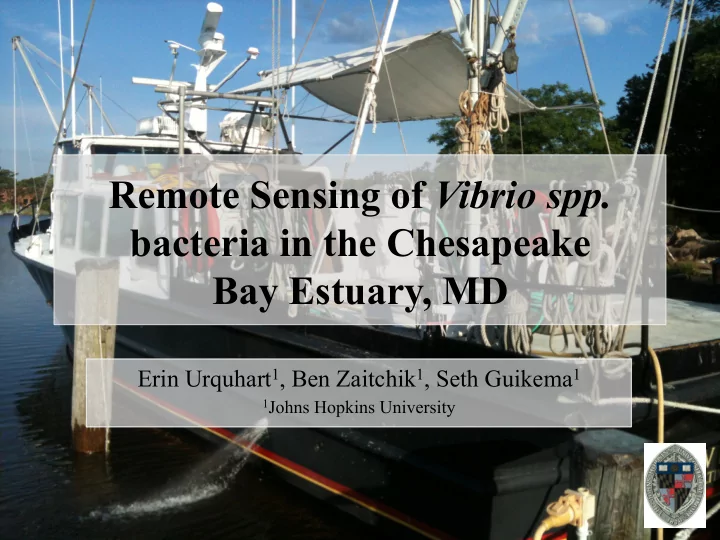

Remote Sensing of Vibrio spp. bacteria in the Chesapeake Bay Estuary, MD Erin Urquhart 1 , Ben Zaitchik 1 , Seth Guikema 1 1 Johns Hopkins University
Vibrio in Chesapeake Bay • V. cholerae • V. parahaemolyticus • V. vulnificus Sunlight ¡ Climate ¡ ENVIRONMENT ¡ PHYSICAL ¡PARAMETERS ¡ HUMANS ¡ • Precipita2on ¡ • Circula2on ¡ • Sea ¡surface ¡height ¡ BIOLOGICAL ¡PARAMETERS ¡ • SST ¡ • Salinity ¡ • Nutrients ¡ • pH ¡ • Bacteria ¡ • Shellfish ¡ Untreated ¡ • Copepods ¡ • Rec. ¡water ¡ sewage ¡ Urquhart et al. 2 nd Symposium on Advances in Geospatial Technologies for Health August 27, 2013 Session 30: ISPRS: Infectious and Vector-borne Diseases II
Vibrio in Chesapeake Bay * V. vulnificus * V. parahaemolyticus Urquhart et al. 2 nd Symposium on Advances in Geospatial Technologies for Health August 27, 2013 Session 30: ISPRS: Infectious and Vector-borne Diseases II
Remote Sensing of Vibrio spp. in Chesapeake Bay z ( V.v. )= -7.867 + (0.316 * Temp) + (-0.342 * (|Saln- 11.5|) Urquhart et al. (2012) RSE Urquhart et al. 2 nd Symposium on Advances in Geospatial Technologies for Health August 27, 2013 Session 30: ISPRS: Infectious and Vector-borne Diseases II
Percent Satellite Coverage by Month Urquhart et al. 2 nd Symposium on Advances in Geospatial Technologies for Health August 27, 2013 Session 30: ISPRS: Infectious and Vector-borne Diseases II
Percent Satellite Coverage by Month & Station Urquhart et al. 2 nd Symposium on Advances in Geospatial Technologies for Health August 27, 2013 Session 30: ISPRS: Infectious and Vector-borne Diseases II
Urquhart et al. 2 nd Symposium on Advances in Geospatial Technologies for Health August 27, 2013 Session 30: ISPRS: Infectious and Vector-borne Diseases II
Remote Sensing of Vibrio spp. in Chesapeake Bay z ( V.v. )= -7.867 + (0.316 * Temp) + (-0.342 * (|Saln- 11.5|) Urquhart et al. (2013) RSE Urquhart et al. 2 nd Symposium on Advances in Geospatial Technologies for Health August 27, 2013 Session 30: ISPRS: Infectious and Vector-borne Diseases II
z ( V.c. )= -1.1939 + (0.1233 * Temp) – (0.1997 * Saln) – (0.0324 * (Temp * Saln) z ( V.v. )= -7.867 + (0.316 * Temp) + (-0.342 * (|Saln- 11.5|) Urquhart et al. 2 nd Symposium on Advances in Geospatial Technologies for Health August 27, 2013 Session 30: ISPRS: Infectious and Vector-borne Diseases II
V. vulnificus & V. parahaemolyticus Field Sampling Urquhart et al. 2 nd Symposium on Advances in Geospatial Technologies for Health August 27, 2013 Session 30: ISPRS: Infectious and Vector-borne Diseases II
Vibrio spp. Modeling in the Chesapeake Bay • V. vulnificus and V. parahaemolyticus • 148 surface samples • Mar.-Sept. (2011 & 2012) • Probability of presence algorithms • Generalized Linear Model (GLM) • Generalized Additive Model (GAM) • Random Forest (RF) • Optimal prediction point • Bacteria abundance algorithms • HYBRID abundance algorithms • GAM/RF Urquhart et al. 2 nd Symposium on Advances in Geospatial Technologies for Health August 27, 2013 Session 30: ISPRS: Infectious and Vector-borne Diseases II
Vibrio spp. Modeling in the Chesapeake Bay • Probability of presence V. vulnificus V. parahaemolyticus Model GLM GAM RF GLM GAM RF ACC 0.63 0.72 0.68 0.62 0.68 0.67 • Abundance V. vulnificus V. parahaemolyticus Model GLM GAM RF MEAN GLM GAM RF MEAN MAE 4.69 4.79 3.87 4.39 7.43 7.51 5.76 6.34 • HYBRID abundance V. vulnificus V. parahaemolyticus ABUNDANCE 3.87 4.39 5.76 6.34 HYBRID/P 2.79 4.30 4.36 5.83 HYBRID 2.94 3.44 5.26 6.12 Urquhart et al. 2 nd Symposium on Advances in Geospatial Technologies for Health August 27, 2013 Session 30: ISPRS: Infectious and Vector-borne Diseases II
Summary • Vibrio spp. in the Chesapeake Bay • Remote sensing and spatial interpolation • Vibrio spp . qualitative and quantitative model development Next Steps • Hindcast trend analysis • Vibrio spp. risk assessment Urquhart et al. 2 nd Symposium on Advances in Geospatial Technologies for Health August 27, 2013 Session 30: ISPRS: Infectious and Vector-borne Diseases II
Acknowledgments Johns Hopkins University , Rebecca Murphy, Matt Hoffman, Darryn Waugh Cornell University , Dr. Bruce Monger University of Delaware , Erick Geiger University of Maryland, Bradd Haley, Elisa Taviani, Arlene Chen, Rita Colwell, Anwar Huq NASA Goddard, Molly Brown, Carlos Del Castillo Funding Sources Johns Hopkins University, NASA, NSF, NIH
Satellite-derived Salinity Algorithms - MODIS-Aqua Ocean Color Standard Products • 10 Remote sensing reflectances (visible) • 2003-2010 - In situ – remote sensed measurement matchups • 68 CBay Program in situ stations • Single pass RS ocean color data • 1km radius RS averaging • 2003-2010 - Salinity Prediction Models • GLM • CART • GAM • BCART • ANN • RF • MARS • BART - Cross- validation study
Satellite-derived Salinity Algorithms GAM ANN GLM CART BCART RF MEAN BART MARS MAE 1.82 1.85 1.93 2.39 2.38 2.06 3.72 2.04 1.98 RMSE 2.38 2.50 2.53 3.03 3.01 2.67 4.69 2.60 2.52 MAE GLM GAM ANN MEAN East for West 2.1 1.8 1.7 3.3 West for East 2.6 2.8 4.0 4.1 North for South 3.4 2.1 5.9 5.7 South for North 3.0 6.4 6.1 5.7 High for Low 2.3 2.3 2.6 4.2 Low for High 2.5 2.3 2.8 3.9 • Top performing prediction models: GAM and ANN • All models outperform MEAN • GLM and GAM are fairly generalizable in a cross-validation study Urquhart et al. (2012). RSE
Recommend
More recommend